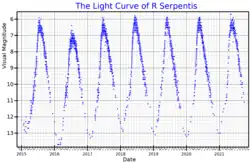R Serpentis
R Serpentis is a Mira variable type star in the equatorial constellation of Serpens. It ranges between apparent magnitude 5.16 and 14.4, and spectral types M5e to M8e, over a period of 356.41 days.[5][11] The variability of this star was discovered in 1826 by Karl Ludwig Harding.[12]
| Observation data Epoch J2000 Equinox J2000 | |
|---|---|
| Constellation | Serpens |
| Right ascension | 15h 50m 41.73245s[2] |
| Declination | +15° 08′ 01.0810″[2] |
| Apparent magnitude (V) | 9.70[3] |
| Characteristics | |
| Spectral type | M5-8e[4] |
| B−V color index | 1.500±0.510[3] |
| Variable type | Mira[5] |
| Astrometry | |
| Radial velocity (Rv) | 23.8±0.8[6] km/s |
| Proper motion (μ) | RA: +2.387[2] mas/yr Dec.: −36.699[2] mas/yr |
| Parallax (π) | 3.5110 ± 0.2966 mas[2] |
| Distance | 930 ± 80 ly (280 ± 20 pc) |
| Details | |
| Radius | ~380[7] R☉ |
| Luminosity | 1,704.70[8] L☉ |
| Temperature | 2,780±80[9] K |
| Other designations | |
| Database references | |
| SIMBAD | data |
References
- "Download Data". aavso.org. AAVSO. Retrieved 1 October 2021.
- Brown, A. G. A.; et al. (Gaia collaboration) (August 2018). "Gaia Data Release 2: Summary of the contents and survey properties". Astronomy & Astrophysics. 616. A1. arXiv:1804.09365. Bibcode:2018A&A...616A...1G. doi:10.1051/0004-6361/201833051.
- Anderson, E.; Francis, Ch. (2012), "XHIP: An extended hipparcos compilation", Astronomy Letters, 38 (5): 331, arXiv:1108.4971, Bibcode:2012AstL...38..331A, doi:10.1134/S1063773712050015, S2CID 119257644.
- Keenan, Philip C.; et al. (1974), "Revised Catalog of Spectra of Mira Variables of Types ME and Se", Astrophysical Journal Supplement, 28: 271, Bibcode:1974ApJS...28..271K, doi:10.1086/190318.
- Samus', N. N; Kazarovets, E. V; Durlevich, O. V; Kireeva, N. N; Pastukhova, E. N (2017), "General catalogue of variable stars: Version GCVS 5.1", Astronomy Reports, 61 (1): 80, Bibcode:2017ARep...61...80S, doi:10.1134/S1063772917010085, S2CID 125853869.
- Gontcharov, G. A. (November 2006), "Pulkovo Compilation of Radial Velocities for 35 495 Hipparcos stars in a common system", Astronomy Letters, 32 (11): 759–771, arXiv:1606.08053, Bibcode:2006AstL...32..759G, doi:10.1134/S1063773706110065, S2CID 119231169.
- Pasinetti Fracassini, L. E.; et al. (February 2001), "Catalogue of Apparent Diameters and Absolute Radii of Stars (CADARS)", Astronomy and Astrophysics (Third ed.), 367: 521–524, arXiv:astro-ph/0012289, Bibcode:2001A&A...367..521P, doi:10.1051/0004-6361:20000451, S2CID 425754.
- McDonald, I.; et al. (2012), "Fundamental parameters and infrared excesses of Hipparcos stars", Monthly Notices of the Royal Astronomical Society, 427 (1): 343–357, arXiv:1208.2037, Bibcode:2012MNRAS.427..343M, doi:10.1111/j.1365-2966.2012.21873.x, S2CID 118665352.
- Hofmann, K. -H.; et al. (January 2002), "Observations of Mira stars with the IOTA/FLUOR interferometer and comparison with Mira star models", New Astronomy, 7 (1): 9–20, arXiv:astro-ph/0004013, Bibcode:2002NewA....7....9H, doi:10.1016/S1384-1076(01)00085-9, S2CID 14854720.
- "R Ser". SIMBAD. Centre de données astronomiques de Strasbourg. Retrieved 5 September 2018.
- Watson, Christopher (4 January 2010). "R Serpentis". AAVSO Website. American Association of Variable Star Observers. Retrieved 22 May 2014.
- Zsoldos, E. (1994). "Three Early Variable Star Catalogues". Journal for the History of Astronomy. 25 (2): 92–98. Bibcode:1994JHA....25...92Z. doi:10.1177/002182869402500202. S2CID 117099222.
This article is issued from Wikipedia. The text is licensed under Creative Commons - Attribution - Sharealike. Additional terms may apply for the media files.
